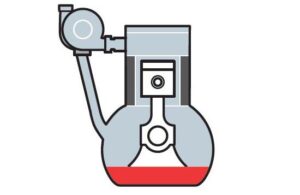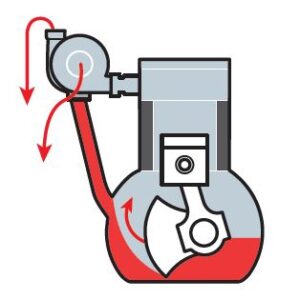Turbo Feed Line on the Block Side Leaking
Common turbo failure – oil leaks
What are oil leaks
Oil leaks can be caused by a variety of factors, the main factor being incorrect pressure within the compressor and turbine housings. Oil leaks can cause catastrophic damage to the bearing systems and occur within seconds of the turbocharger commencing operation.
When a turbocharger is installed correctly, it should NOT leak oil, however, there can be cases where oil leaks occur. The following highlights some of the main causes and signs of oil leaks.
Example of correct pressures

The above diagram shows the correct oil pressure in both housings resulting in no leaks from the turbo.

PLEASE NOTE – An oil leak can also occur when engines are running on idle. The pressure within the housings is lower, which in turn can lead to a vacuum being created, causing the oil to leak into the turbine housing. Once the engine starts to run at normal speeds the pressures will be restored and the leaks will stop.
Causes of oil leaks
Incorrect fitting of the intake pipe/hose
Blockages to the air intake pipe/hoses
Blockages to the air intake filter
Fitting the incorrect turbocharger
Incorrect pressure in the compressor end
Dirty air filter over time due to natural build up
Damaged or cracked compressor housing
Blockages in the exhaust system
Fitting the incorrect turbocharger
Physical damage to the turbo's rotating parts and excessive bearing clearance (possibly caused by other failure modes)
Excessively high oil pressure
Excessive crank case pressure (blow-by from worn piston rings/bores)
Increased crank case pressure
Use of silicon sealant / incorrect gasket
Repeated hot engine shutdowns leading to carbon deposits (coke) in the centre housing
Twisted, bent or trapped oil return pipe
Collapsed turbine piston ring from excessive EGT's
Incorrect pressure in the turbine end
Leaks with in the exhaust system
Fitting the incorrect turbocharger
Cracks in turbine housing, sometimes only visible when hot
Examples of how oil leaks can occur:

If there is a kink, bend, twist or partial blockage in the oil return pipe, this will cause the oil pressure to build up in the bearing housing, resulting in leaks from both turbine and compressor ends.

If the oil level is too full there will be nowhere for the oil to flow, causing a build-up of oil pressure in the bearing housing. This will cause oil to leak from both the turbine and compressor ends.

If the oil level is higher than specified by the engine manufacturer, the oil could to be forced back up to the oil return pipe with the motion of the crank, restricting the flow. This will cause leaks from both ends.

If there is a loss or increase of pressure in the compressor end or turbine end, this will cause oil leak in either the turbine or compressor end.

'Piston ring blow by' and 'crank case blow by' cause the same effect, they increase the pressure in the crank case. This affects the oil flow to the turbo at the correct rate needed and acts as a restriction to the oil return pipe, causing the turbo to leak oil in either of the turbine end or compressor end.

PLEASE NOTE – Oil leaks can occur on VSR (high speed) balancing machines as the ambient pressures required to create the seal are not present as no housings are used. This can then force out oil from both the compressor end and turbine end giving the impression of a leak. This is unlikely to occur when the replacement turbo is fitted to the engine.
Preventing oil leaks
- Ensure air and oil drain systems are clear from blockages or restrictions
- Check the exhaust system to make sure there are no leaks present
- Do not use silicone on oil gaskets as it can easily become detached and block oil passages Ensure DPF (diesel particulate filter) and Catalytic converter are free of blockages
- Use the correct gaskets and o-rings
- Only use the correct standard of turbine housings and compressor housings
- Check for correct oil levels and pressure
Jubilee Bank Holiday opening hours
Melett UK will close for the Jubilee bank holiday at 17:00 on Wednesday 01 June and reopen at 08:00 on Monday 06 June.
Any orders that are not picked or dispatched before we close will resume preparation when we reopen. If you would like any more information or guidance on the above, please contact our customer care team on +44 (0)1226 320939.
Memorial Day 2022
Melett North America will be closed for Memorial Day on Monday May 30th and will reopen at 8.00 am on Tuesday May 31st.
Melett Poland
Melett Polska will be closed for a public holiday on Thursday 16th June and will reopen on Friday 17th June. Any orders that are not picked or dispatched before we close will resume preparation when we reopen. If you would like any more information or guidance on the above, please contact our customer care team on +44 (0)1226 320939.
May Bank Holiday opening hours
Melett UK
Will close 5.00 pm Friday 29th April and reopen 8.00 am Tuesday 3rd May
Melett Poland
Will close 4.30 pm Friday 29th April and reopen 8.00 am Wednesday 4th May
PLEASE NOTE -THE ABILITY TO SUBMIT YOUR ORDERS THROUGH THE MELETT WEBSITE HAS BEEN RESTORED
We are delighted to advise full website functionality has now been restored, meaning you can view stock and pricing, add parts to your basket and submit your order via the website. In addition, all turbo/part number searches are fully working.
Until further notice please place your orders by 2.30 pm and we will endeavour to dispatch the same day dispatch.
We will keep you updated as we navigate through the remaining internal connectivity issues, we have dedicated teams working round the clock to resolve any remaining issues as quickly as possible.
We, at Melett, would like to stress our gratitude for your continued patience and support throughout this difficult time.
Please note you can now view your pricing on the Melett website.
We appreciate this is not a complete solution at this stage, however, please be assured our internal website and IT teams remain focused on reinstating the stock availability function.
We cannot stress enough that we are doing everything we can to reconnect our internal system, and we will restore full website functionality as soon as possible.
If you experience any problems whilst ordering online, please do not hesitate to contact:
[email protected] / 1-901-322-5896 • Toll Free: 1-855-235-9706
Thank you the Melett team
W związku z awarią sieci telefonicznej prosimy o kontakt na telefon komórkowy: Damian 512 372 612; Kasia 511 372 612
Melett UK will be closed on Monday 29th August and will reopen at 8.00am on Tuesday 30th August.
Any orders that are not picked or dispatched before we close on Friday 26th August will resume preparation when we reopen. If you would like any more information or guidance on the above, please contact our customer care team on +44 (0)1226 320939.
We are delighted to advise full website functionality has now been restored, meaning you can view stock and pricing, add parts to your basket and submit your order via the website. In addition, all turbo/part number searches are fully working.
Please place your order by 4pm for same day dispatch.
We, at Melett, would like to stress our gratitude for your continued patience and support throughout this inconceivable time.
Easter opening hours
Melett UK - will close 17:00 Thursday 14 April and reopen 08:00 Tuesday 19 April
Melett Polska - will close 16:30 Thursday 14 April and reopen 08:00 Tuesday 19 April
Due to essential maintenance, the Melett website will be temporarily unavailable on Thursday 14 April from 17:30 to 19:30.
We apologise for any inconvenience caused.
Essential Maintenance
Due to essential maintenance, the Melett website will be temporarily unavailable on Friday 25 February from 18:00 to 20:00 (GMT). We apologise for any inconvenience caused.
Planned maintenance – Thursday 24 March 2022
We will be undertaking planned maintenance on our internal systems this evening between 17:00 and 20:00 GMT, which will affect some website functionality.
We aim to keep disruption to a minimum and the website will remain online. However, we will need to temporarily disable online ordering during this time.
Thank you for your understanding.
Essential Maintenance
We are undertaking essential maintenance this weekend (February 19-20) and some of our website services may be unavailable at times. We apologise for any inconvenience this may cause.
Essential Maintenance
- Due to essential maintenance, the Melett website will be temporarily unavailable on Friday 28 January from 18:00 to 20:00 (CET). We apologise for any inconvenience caused.
Festive opening hours
- Melett UK Will close 5:00pm Thursday 23rd December and reopen 8:00am Tuesday 4th January
- Melett Polska Will close 4:30pm Thursday 23rd December and reopen 8:00am Monday 3rd January
- Melett North America Will close 5:00pm Thursday 23rd December and reopen 8:00am Monday 3rd January
Dismiss Close
Please note: Due to essential maintenance the Melett website will be temporarily unavailable on Friday 10 December from 5:00PM (CET) to 11:00PM (CET).
Apologies for any inconvenience caused.
Please note; Unfortunately, we are experiencing processing delays for all orders which may result in delays in shipping. If possible, please confirm orders at your earliest opportunity to help minimise disruption to our normal high standards. Please accept our apologies and rest assured that we are working hard to resolve the issue.
Melett Poland will be closed for a Public Holiday on Thursday 11th November.
Any orders that are not picked or despatched on Wednesday 10th November will resume preparation when we return on Friday 12th November.
Melett Poland will be closed for a Public Holiday on Thursday 6th November.
Any orders that are not picked or despatched on Wednesday 5th November will resume preparation when we return on Friday 7th November.
Melett will be closed for a Public Holiday on Thursday 11th November.
Any orders that are not picked or despatched on Wednesday 10th November will resume preparation when we return on Friday 12th November.
Melett will be closed from 5 pm on Wednesday 24th November until 8 am on Monday 29th November for the Thanksgiving holiday
Online ordering now available
In addition to viewing inventory levels and pricing, you can now place orders directly from our website. Download our user guide below to help you get started.
Download user guide
Notification
Melett UK will be closed for a Public Holiday on Monday 30th August.
Any orders which are not picked or despatched on 27th August will resume preparation when we return on Tuesday 31st August.
Notification
Melett North America will be closed for a Public Holiday on Monday 6th September.
Your browser is no longer supported
Internet Explorer is approaching end-of-life and no longer supports some of the complex functionality of the Melett website.
For the best and most secure experience, please switch to a modern browser, such as Google Chrome, Microsoft Edge, or Firefox.
johnsonyesseresels.blogspot.com
Source: https://www.melett.com/technical/why-turbos-fail/oil-leaks/#:~:text=Oil%20leaks%20can%20be%20caused,of%20the%20turbocharger%20commencing%20operation.
0 Response to "Turbo Feed Line on the Block Side Leaking"
Yorum Gönder